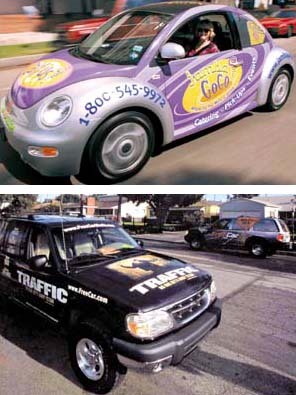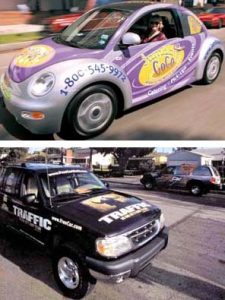Imagine driving along when something costumed in colorful, high-tech graphics attracts your attention. Taking a closer look, you discover it’s only another vehicle. But it’s no ordinary vehicle. Rather, it’s an ad-wrapped car — also known as a moving billboard — decked out in eye-catching advertising messages. To compete in their respective markets, advertisers seek unique ways to get consumers’ attention. One way is to hire people to drive cars wrapped in bold advertising messages through busy streets. Originally a West Coast phenomenon, car wraps are now moving eastward, and the companies behind them offer various products and services. Bumper2Bumper Media Inc. (Greenville, SC) works with advertisers to develop unique, eye-catching designs and messages. President Phillip Day says, "We work with advertisers directly. They can use their own vehicles, or we give them access to cars that are owned by drivers paid to carry messages." Demographic targeting systems allow advertisers to select drivers in the most densely populated urban areas. Another company, Los Angeles-based FreeCar Media, uses its Website to register prospective drivers willing to have their own cars wrapped with advertising messages, or interested in driving existing, wrapped vehicles. Because FreeCar Media is advertiser supported, a driver can receive a new car to drive for two years, or have a personally owned vehicle wrapped — and get paid for driving it. To reduce high installation costs, FreeCar Media works closely with regional installers and actively seeks ways to train new installers on how to properly wrap vehicles. To track a vehicle’s location at any time, Bumper2Bumper Media and FreeCar Media offer advertisers the option of a small, satellite Global Positioning System device. Still wondering what’s driving the success of this new medium? Just as billboards benefited from the advent of virtually seamless, colorful, computer-printed graphics in the 1970s, today, vehicle graphics can garner the same kind of attention. Plus, with today’s consumers spending an average of 90 minutes per day in their cars (according to 1995 figures from the NDP group, an international, marketing-information provider), this new medium is a perfect complement to any outdoor campaign. In its January 13 edition, The Washington Post published an article stating that this advertising form didn’t really take off until 1993, when 3M developed a process to transfer images onto adhesive vinyl that could adhere to the surface of any vehicle. During this same time, outdoor marketers began wrapping buses, trucks and rail cars. FreeCar Media COO Keith Powers notes that a good deal of time is spent on research and development, as well as thinking ahead about delivery. He says, "We offer a mix of direct marketing and outdoor, and we deliver quality back to consumers through this alternative method." In the interest of reducing costs, Powers says FreeCar Media has a patent pending on the development of "a futuristic material that will have the ability to change design through digitally transmitted signals." Garnered from FreeCar Media, the playful, yet effective, vehicle-wrap jobs featured here show why this media format is becoming increasingly popular among outdoor advertisers.



 Tip Sheet1 week ago
Tip Sheet1 week ago
 Ask Signs of the Times3 days ago
Ask Signs of the Times3 days ago
 Real Deal1 week ago
Real Deal1 week ago
 Benchmarks5 days ago
Benchmarks5 days ago
 Photo Gallery21 hours ago
Photo Gallery21 hours ago
 Editor's Note2 weeks ago
Editor's Note2 weeks ago
 Women in Signs1 week ago
Women in Signs1 week ago
 Photo Gallery1 week ago
Photo Gallery1 week ago











